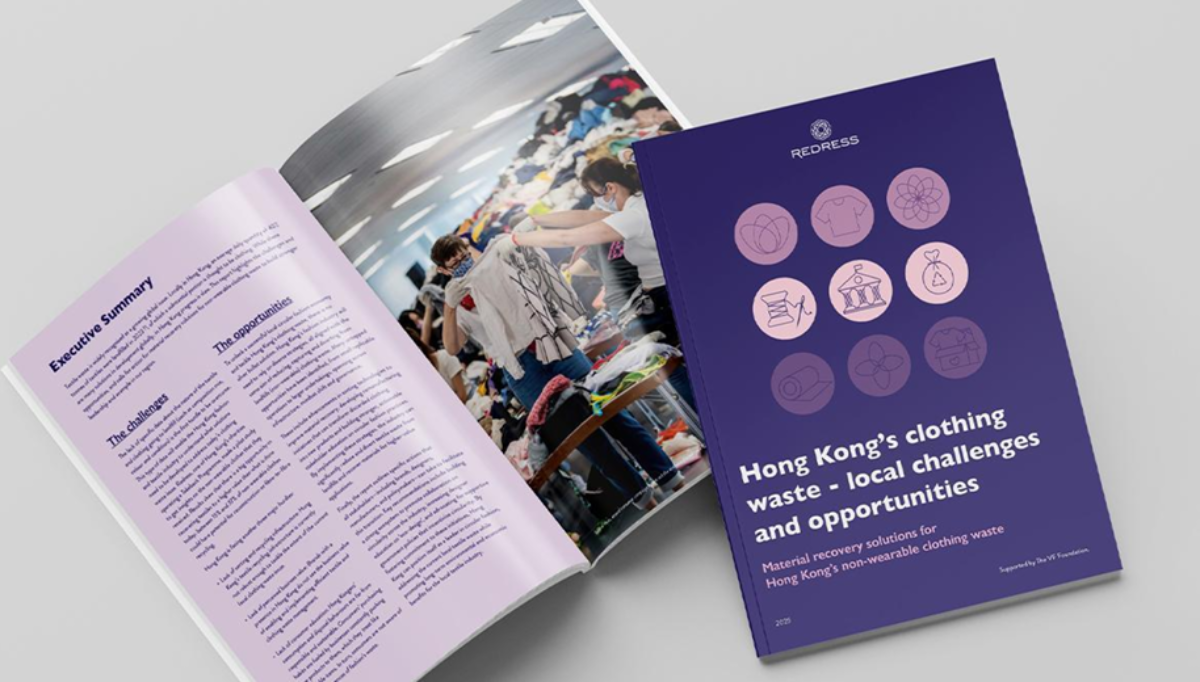Redress, the leading Asia-focused environmental NGO driving circular fashion, released its mission-critical report ‘Hong Kong’s Clothing Waste: Local Challenges and Opportunities’, supported by The VF Foundation, uncovering the scale of the city’s textile waste crisis while proposing innovative solutions to transform non-wearable clothing from landfill to valuable resources.
Key Findings: Hong Kong’s Fashion Waste Crisis
The report identifies three core pillars that affect the fashion waste crisis in Hong Kong including insufficient recycling infrastructure, low business incentives for brands, and gaps in consumer education. Solutions range from automated sorting technologies, to remanufacturing projects, as demonstrated through Redress’ Designer Residency programme. Some arresting data points noted in the report include:
- 402 tonnes of textiles landfilled daily in Hong Kong[1] – the equivalent of 17,480 suitcases of discarded garments every single day[2]
- Landfills near capacity: At current rates, Hong Kong’s landfill space is expected to run out by 2026[3]
- High-value recovery potential: 19% of non-wearable clothing could be upgraded from downcycling to fibre-to-fibre recycling or reconstruction[4]
- Cotton conundrum: Over 25% of non-wearable textiles are 100% cotton, ideal for recycling, but only 11% are recovered for apparel reuse[5]
“Hong Kong’s fashion waste is a costly problem—and an opportunity. Our findings show that with better sorting technologies, smarter policies, and designer innovation, we can truly transform waste into valuable resources. The alternative is immense environmental and economic loss,” said Nissa Cornish, Executive Director of Redress. “Circular fashion gives us the opportunity to rethink waste, not as a burden, but as a resource. By investing in education, empowering designers to create with end-of-life in mind, holding the industry accountable for its impacts, and encouraging supportive policies and regulations, we can shift towards a system that benefits both the planet and our economy.”
Recommendations
The new report urges action from all sectors to build a more sustainable future for fashion. Brands and manufacturers are called on to adopt circular design principles, invest in local textile recycling infrastructure, and commit to using recycled fibres in their products. The government is encouraged to implement Extended Producer Responsibility (EPR) schemes and supportive policies that incentivise circular textile systems, drawing on successful models from the EU. Meanwhile, consumers play a vital role by embracing mindful consumption — buying less, choosing better, and supporting brands that prioritise sustainability throughout their supply chain.
Circular Fashion Advocacy and Solutions Within Reach
This report marks an important milestone for Redress, coming on the heels of wrapping up Get Redressed Month—Hong Kong’s largest consumer awareness campaign for circular fashion—and celebrating a milestone anniversary of the Redress Design Award, the world’s leading sustainable fashion design competition now in its 15th year.
Throughout the month of May, Redress invited the public to give new life to unwanted clothes with over 120 clothing drive locations across Hong Kong. During Get Redressed Month, Redress presented its largest interactive exhibition yet, ‘Redressing the Future: Circular Solutions for Fashion Waste’, hosted 21 educational talks, and welcomed over 600 volunteers at the Sort-a-thon to sort through 17.9 tonnes of collected clothing for redistribution to local charities, resale, or responsible downcycling.
Designing the Future for Fashion with Redress Design Award
As Redress marks the 15th anniversary of the Redress Design Award, ‘Hong Kong’s Clothing Waste: Local Challenges and Opportunities’ highlights designers as catalysts for circularity. Over the past decade, Redress has supported over 10,000 fashion designers across Asia with education, and with competition alumni contributing to global brands, launching their own sustainable labels or becoming educators themselves. Showcasing the implementation of circular design practices and advocating for change at the design stage, their work demonstrates:
- Sustainable design leadership: Designers are applying innovative design techniques to transform non-wearable clothing into new high-value fashion collections.
- Remanufacturing innovation: Designers like Damini Mittai, Tiffany Pattinson and Tulika Ranjan are turning unwearable textile waste into high-value products – from art to accessories.
- Consumer education: Designers serve as ambassadors, bridging the gap between responsible production and conscious consumption.
[1] Environmental Protection Department, HKSAR. 2024. Monitoring of Solid Waste in Hong Kong: Waste Statistics for 2023
[2] Estimation by Redress, based on a 23kg suitcase
[3] HKFP June 2024, Explainer: How big is Hong Kong’s waste problem, and how much does it recycle?
[4] Redress, 2025. Hong Kong’s Clothing Waste: Local Challenges and Opportunities.
[5] Redress, 2025. Hong Kong’s Clothing Waste: Local Challenges and Opportunities.
Legal Disclaimer: The Editor provides this news content "as is," without any warranty of any kind. We disclaim all responsibility and liability for the accuracy, content, images, videos, licenses, completeness, legality, or reliability of the information contained in this article. For any complaints or copyright concerns regarding this article, please contact the author mentioned above.

















